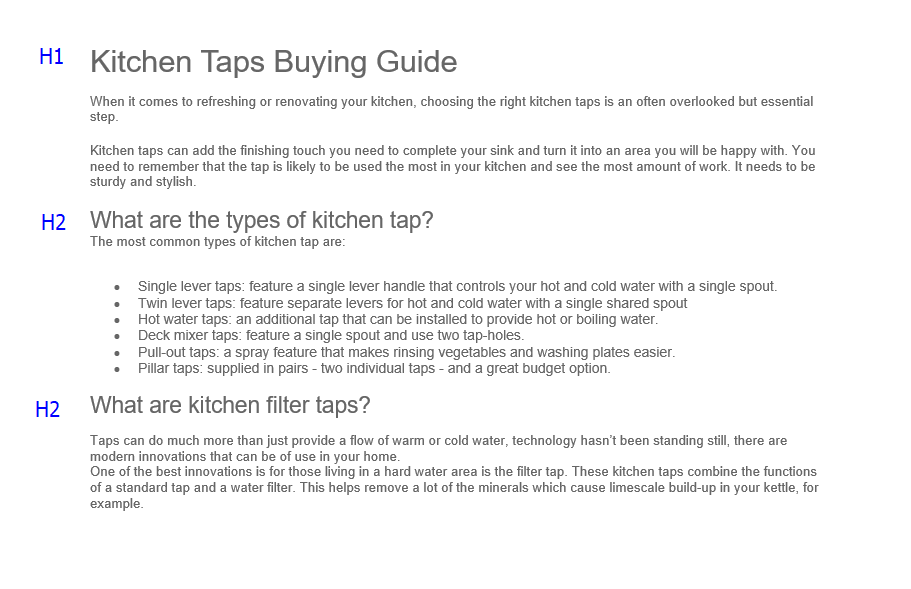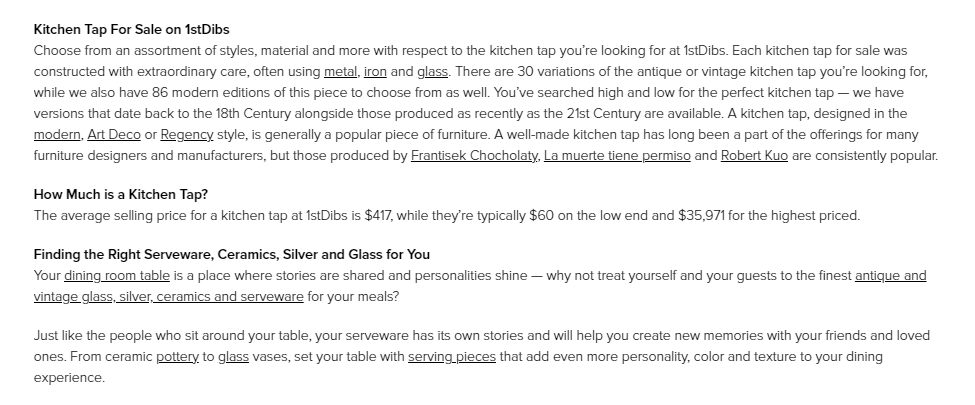Content is one of the key ranking factors in modern search engine optimization. But an outdated idea of how to create it can not only prevent you from taking positions, but also put your project at risk for filters and Index.
"Write a text on the topic of building materials, the volume of 2000-3000 characters without spaces, using keywords: building sand, pit sand, buy, Washington. The text should be factual, literate, accurately corresponded to the plan".
This is roughly what a typical terms of reference for seo text looks like. If you increase the volume to 16000-18000 characters without spaces, this is already a typical Terms of Reference for a seo article.
Despite the fact that such a text will be useless for the reader, created in the style of Captain Obvious, there is also a risk that the writer will rewrite the factual errors of other articles.
When selecting partners to collaborate with, we send our SEO article and SEO text writing guide with the purpose of coming to a common sense of good text even before the first approval.
Part One. How to Write SEO Texts
SEO texts are classic optimized texts that are often found on the pages of online stores. They may describe catalog sections and contain the main keywords for promotion. Often such content is partially hidden from users, as it is not marketing.
Let's divide the texts into those that help to promote transactional queries and those that focus on informational queries – this group includes blog articles with content seeding in social networks and paid distribution. Let's focus only on transactional queries, as they are the most problematic, mythical, and outdated techniques.
The rules of writing SEO texts (do not over-spam, do not obfuscate, etc.) are already stated in many books and articles, so instead of reviewing theory, let's move on to practical examples that clearly show the failings and mistakes.
Bad:
1. Bold keywords in the text on a page
It's reasonable to use bold for search queries only in a word document to track the usage of all keys. Bold type does not affect promotion, so it is not necessary.
2. Over-spamming / excessive keywords
Over-spammed text is not difficult to read, and search engines perceive it negatively. Especially diligent authors risk facing penalties from Google. The optimal number of queries is no more than one per paragraph, no more than three (with morphology) for the whole text.
3. Texts for robots
These are texts where key queries are inserted in the form in which they were copied from services for searching keywords. You will neither find the phrase "Buying Kitchen Tap" in an ordinary brochure, nor hear it in everyday speech. It would rather sound like this: "Kitchen Tap for Sale".
Important:
- You can break up key queries with one or two words.
- Don't be afraid of indirect queries. ("buy a mixer in Washington" = "mixers in Washington", etc.). Search engines understand morphology perfectly well. Even if the words are "witched" (put at some distance between words).
Good:
1. Small number of keywords
An overabundance of queries in one text will immediately show both the reader and the search engine that the text you wrote with a single purpose – to fit all the keys on this page. But Google is not so stupid, it will not rank highly an over-spammed site. For the text, it is best to choose three or four main queries and up to five additional ones for which you plan to promote.
2. Use h1, h2 headings
Breaking up the text with headings will make it search engine friendly and convenient to your customers.
The h1 heading is located at the very beginning of the text, h2 level headings are subheadings, there can be several of them in the text.
3. Interlinking in texts
Interlinking is a system of internal links from one page of your website to another. They help users find answers to their questions faster. In addition, it allows you to influence the search results by means of behavioral factors.The more time a user spends on the website actively, the better the site is according to search engines.
Checklist for Creating SEO Text
We use this checklist to write and check SEO texts.
Standardized requirements save time for evaluating incoming material and giving feedback to a specialist.
General requirements
— Uniqueness 85% and above
— Volume in accordance with the terms of reference(1500 characters without spaces and above);
— Using keywords:
- One keyword mentioned not more than twice in the text
- Not more than one query in one paragraph
Contents*
- Introduction (1 paragraph)
- Answer to the question, description of the first paragraph (2 paragraphs)
- Description of the second paragraph, problem solving (2 paragraphs)
- Conclusion, contacts, terms of service / delivery (1 paragraph)
Structure and execution
— Headings h1, h2:
- Main key query as h1 headline
- Additional query as h2, if possible.
— Interlinking to other sections / articles
— Using lists
— Breaking thoughts into paragraphs of 3-7 lines.
Literacy
— Text checking in online services
— Proofreading aloud to make sure the text is coherent and easy to comprehend
*As for content, the checklist varies depending on the purpose of the text.
Example of SEO text evaluation
Expectations from the form and content of the text are described. Let's see how it works on the example of an SEO text for an online store. We won't discuss style and presentation of information, now we are only interested in the technical side of the issue.
The keywords are marked in color blue based on my own practice. Let's check the text according to the checklist.
| Checklist | Results | |
| Uniqueness 85% and above | – | |
| Volume in accordance with the terms of reference(1500 characters without spaces and above) | 2543 | ✅ |
| Using keywords (frequency) | There are too many keywords in the first and second paragraphs. Solution: use them in other paragraphs or increase the volume of the text. | ❌ |
| Introduction | The introduction can be shortened to one paragraph | ✅ |
| Types of cat food (dry, wet) | Described | ✅ |
| Conclusion | There is no conclusion. I recommend adding one paragraph of general summary. | ❌ |
| Headings h1, h2 | Check | ✅ |
| Interlinking to other sections / articles | There is no interlinking | ❌ |
| Using lists | It’s not crucial, but I recommend to list types of cat food | ❌ |
| Breaking thoughts into paragraphs of 3-7 lines | Check | ✅ |
| Literacy check | No mistakes | ✅ |
Recommendations:
- Break up the queries in the 6th and 9th paragraphs;
- Reduce the frequency of keyword usage in the first and second paragraphs
- Add conclusion
- Add interlinking
Result – minimum edits, maximum usefulness.
Part Two. How to Write SEO Articles
An SEO article is an optimized text that is valuable to the reader. It is created not for search engines, but for users. The only thing behind the prefix SEO is the presence of keywords.
Such content can be a good source of organic traffic. Just like eco SEO, it does not cause user rejection and increases brand loyalty.
SEO text vs SEO article
In terms of optimization, there is almost no difference between SEO articles and SEO texts. Both contain key queries, are essential for the promotion of the page and are written within the scope of the terms of reference. But the principles behind their creation are quite different. Let's see exactly how they differ.
| SEO text | SEO article |
Topic coverage level
| Superficial or average | Above average or high |
Keyword usage
| ✅ | ✅ |
Heading h1, h2 usage
| ✅ | ✅ |
Writing resources
| Copywriter | Copywriter + expert |
Typical volume
| 1500-2000 characters | 3000 characters and more |
How does the SEO article work?
Such content meets the user's expectations. For example, the reader wants to entertain themselves, improve their work or learn something new – the material helps them do that (read more about reader experience). In this case, the article is prepared with the attitude to make the most comprehensive, valuable piece of writing that answers important questions. During the writing process, key queries are added to the text. If the article turns out to be truly interesting and complete, there is a chance to get into the TOP, as it’s beneficial for the search engine itself to provide users with such relevant material.
Content and structure of an SEO article
Usually, an article reveals two or three main thoughts. The author answers an important question, covers a popular topic from a new angle, or offers their own expert solution to a user's problem. There are the most popular formats:
- Guide
- Overview of tools / technologies
- Help Article
- Problem-Solution
Why can't freelancers write a high-quality article in most cases?
Freelancers have broad, but not deep (expert) knowledge in many fields. However, the value of an SEO article lies precisely in providing new, insider information, which is impossible to possess without a deep background in the field.
How does an agency write expert seo articles?
The process takes several stages:
1. Preparation of the brief. Answering the questions:
- What is the purpose of the text?
- What should the user do after reading it?
- Who is the target audience?
- What key queries should be considered?
2. Writing the Theses
Following the information in the brief, their own search for problems in the chosen area and keywords, the content specialist writes the theses that become the basis of the article. These theses are agreed with the client, whose experts share information on important issues, and afterwards the copywriter comes up with the finished text.
SEO Article Writing Checklist
1. Choosing a topic
It is important to choose a topic that is not just interesting to you, but also has potentially good content seeding. Special services like serpstat.com or ahrefs.com (both paid) can help you with it.
By collecting the headlines of the most popular articles into one document, you will be able to catch the correlation between them and choose a promising topic.
Such tools as Search Questions and Search Suggestions will help you find the most frequent questions that need to be answered in your content to make it relevant.
2. Choosing key queries
It is important to start by defining the demanded categories and products. Demanded indeed: it often happens that the catalog has 10,000 products, but only 10% are actually bought regularly – this is the first priority for the semantics formation. Don't forget to do semantics scoring to evaluate their effectiveness and priority.
3. Thesis formation
Describe 3-4 theses for the problem that need to be revealed with the help of an expert.
A thesis is a short sentence that makes the meaning of a paragraph clear. To check if you have a good thesis, try to imagine it as a subheading. A good thesis would fit nicely.
4. Writing a text based on expert information
Once you have received the information from the expert, structure and design it into a final text. The copywriter realizes that the expert is not an editor, so the style and tone of the article may not match the presentation of the rest of the materials. During editing it is important not only to correct punctuation and spelling, but also to get rid of fluff and officialese, to make it match the general style of other materials on the website.
The structure of the four main types of SEO articles:
- Guide
Introduction. A brief description of the issue and the technologies to be described.
Main part. Detailed description of the technology, step-by-step implementation. What problems may appear? How to combine with available tools / processes?
Conclusion. A brief conclusion on how the method solves the problem.
- Overview of tools / technologies
Introduction. A brief description of the topic of the article, what the article describes.
Main part. The review itself:
- Main characteristics
- Possibilities of using
- Comparative analysis with similar products
- Your conclusions and recommendations
Conclusion. Brief key results of the overview.
- Help Article
Introduction. Brief description of the essence of the article, definition of the main concept.
Main part. Description of the main aspects of the object of the article:
- History of origin
- Characteristics
- Varieties
- Implementation
- References to additional sources
Conclusion. General description of what the reader has learned from the article.
- Problem-Solution
Introduction. Brief description of the topic of the article, description of the reader's problem.
Main part. Disclosure of the essence of the solution:
- What you're offering
- How exactly it can help
- What problems might come up
- What the specific features of your solution
A step-by-step guide to action.
Conclusion. How your solution helps fix the problem.
Structure and execution
Headings h1, h2
- The main keyword query in the heading h1
- An additional query in the heading h1, if possible
Interlinking with other sections / articles
Visual ease of perception: lists, font sizes, bold/italics, etc.
Literacy
- Text checking in online services
- Proofreading aloud to make sure the text is coherent and easy to comprehend
Example of SEO article evaluation
As an example, let's take the Guide Article that is at the top of the Google results for the query "start your business".
| Volume in accordance with the terms of reference (3000 characters without spaces and above) | 7636 | ✅ |
| Using keywords (frequency) | No over-spam | ✅ |
| Introduction (A brief description of the problem and the content of the article) | Check | ✅ |
| Main part. The main steps description | Check | ✅ |
| Conclusion | Check | ✅ |
| Headings h1, h2 | Check | ✅ |
| Interlinking to other sections / articles | Check | ✅ |
| Visual ease of perception | Check – there are lists, different fonts, italics and bold | ✅ |
| Literacy check | No mistakes | ✅ |
Recommendations: no comments.
KPI
Modern requirements for SEO materials have increased: now they should contain not only a meaningful part, but also interesting, readable and useful information for the user. Scroll depth, heatmap and click map can be used as the metrics of effectiveness.
Summary
The outdated perception of SEO texts as capitalized texts stuffed with keywords should be left in the past, as well as copywriter exchanges. The first place is taken by the meaningful and useful part for the user, which really helps them choose and understand the goods or services. There are quite specific systems for evaluating content, its readability and clicks on links within the article, which should be the reference metrics in evaluating the quality of SEO articles.
At the same time, using standardized checklists systematically can help to reduce dozens of SEO text approvals to one or two. This improves the quality of incoming texts and saves at least two hours of your time.
Writing quality material is more difficult, but if you break this process down into sequential stages of formation and elaboration, writing and approving an article becomes much easier. The described approach allows you to make your article useful for users, and thus of high quality from the point of view of search engines.










